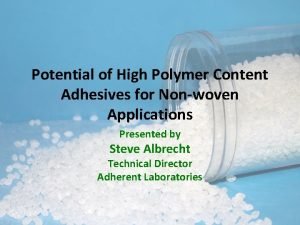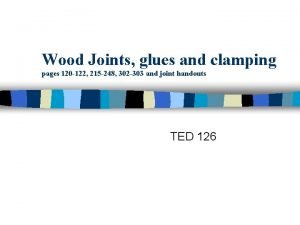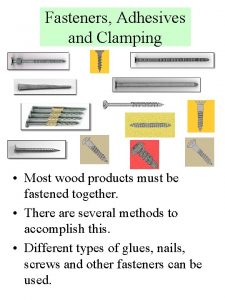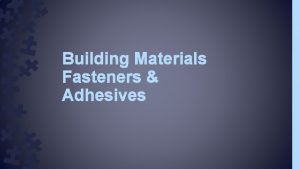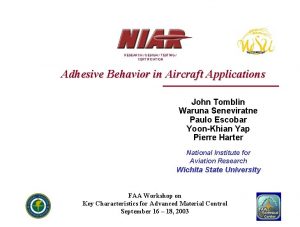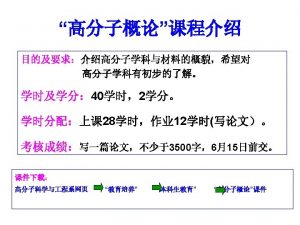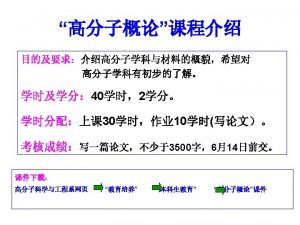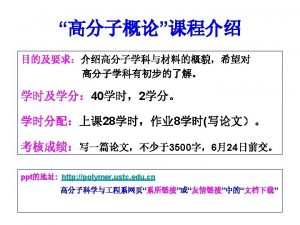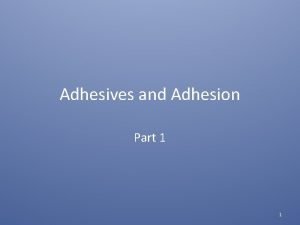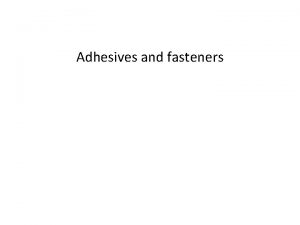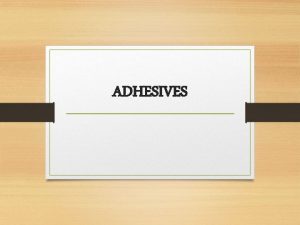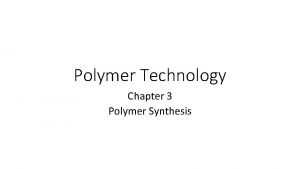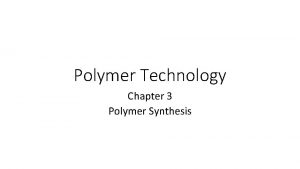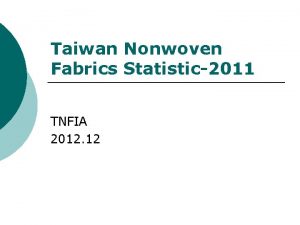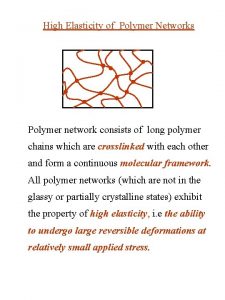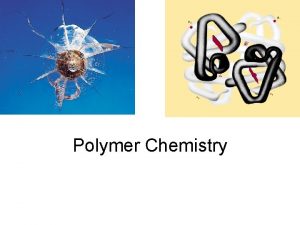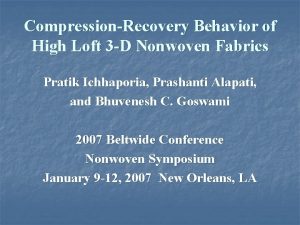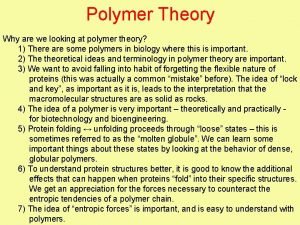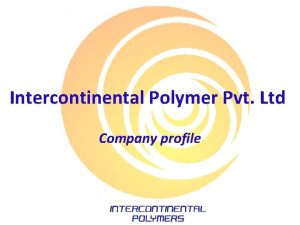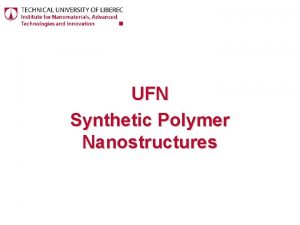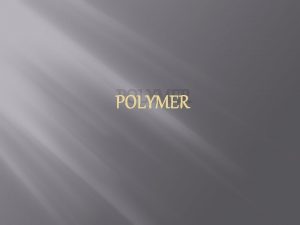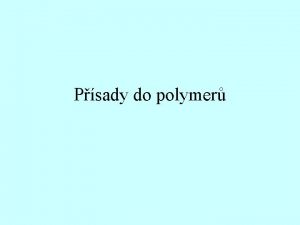Potential of High Polymer Content Adhesives for Nonwoven





















- Slides: 21

Potential of High Polymer Content Adhesives for Non-woven Applications Presented by Steve Albrecht Technical Director Adherent Laboratories

50 Years and Counting…. . • Early 1970’s – Technology was EVA/tackifying resin blends – Low cohesive strength – Not good performance at body temperature • APAO based adhesives introduced in 1975 – Improved thermal resistance of EVA/tackifier – Made from PP by-product from earlier production, then mined and cleaned for use – These materials became scarce later in 1970’s • Process technology minimized by products • Supply of old material expired

SBC Takes the Stage • Start of 1980’s gave technological advance of SBC materials – Low viscosity, high cohesive strength formulations • Highly formulated products – low polymer content – Could be customized for use and application • Needed oil as plasticizer to have PSA character • Rubber came in varieties to impart different properties – Handling of PSA required different equipment and processes • Drum unloader for drums • Emergence of co-extruded pillows, chubs and other packaged forms

SBC – Pros • SBC set and maintained a technological advantage – Further development of polymer grades higher performance adhesives – High Mw and Styrene to minimize rubber and maximize oil for cost savings – Even higher cohesive strength and better application characteristics

SBC – Cons • SBC disadvantages – PSA character – beware of strikethrough – Diaper manufactures wanting to decrease basis weight of back sheet, but SBC formulations had issues in performance – Thermal stability – SBC products degrade fast compared with other polymer bases – Odor of SBC, especially SBS – Raw material shortages affecting different components of formulation – Handling and packaging can be challenging

Olefinic Formulations • Late 1990’s - Single site catalyst polyolefins introduced to adhesive market – High Mw, low polymer content, maximize oil for cost – Great improvement in thermal stability – High oil content may cause problems with cohesive strength at body temperature and strike through – Polymer supply not an issue but other components are still vulnerable

Key Considerations for Adhesive • Good adhesion to substrates – Must stick to both substrates • Cohesive strength at body temperature – Ability to maintain bond • Need to be able to spray adhesive onto substrate – Upper viscosity limits and application temperature are set MW of polymer is limited, which limits cohesive strength • Good thermal stability – Consistency of application • Low odor and light color – Adhesive needs to be undetected to the user of the article • Price and supply stability – Need to know that material is available and predicable in price

Polymer Formulation Strategy for Diaper Construction Adhesives • Polymer – provides cohesive strength and major contributor toward viscosity – Upper viscosity limits of application limit MW of polymer – MW of polymer is determinant of cohesive strength and temperature range – SBC’s have highest cohesive strength relative to melt viscosity of all polymer systems used endblocks

Olefin Formulation Strategy for Diaper Construction Adhesives • Olefin polymers are usually much lower in MW than SBC – Low MW leads to cohesively weak formulations – Low olefin polymer content formulations do not have enough cohesive strength alone – Many polyolefins need to be reinforced to attain needed cohesive strength • Reinforcement materials are normally crystalline in nature – sometimes wax is used

High Polymer Content Olefin Adhesives • New opportunity to make high polymer content adhesives – Crystallinity comes from polymer – Products have high enough cohesive strength at body temp to maintain excellent bond. • Typical formulation – >50% polymer (m. PE, m. PP, EVA, APAO, and blends) – Compatible tackifier – hydrocarbon preferred – No oil needed

Advantages of Binary Blend • Improved cohesive strength over low polymer content, oiled products • Exposure to oil shortages eliminated • Less volatility of product – much reduced odor • Great improvement in thermal stability – consistent application • Can be formed into pellets – Vast improvement in handling of product – Reduces packaging costs, waste of product, and disposal costs • Reduced manufacturing costs

90 80 Grams/22 mm width 70 Signature Spray T-Peel Data – 2 gsm Initial Avg Aged 2 wks @ 50 C Aged 4 h @ 100 F, run @ 100 F 60 50 40 30 20 10 0 >50% m. PE/Tack >50% m. PE (low >50% m. PP/tack MW)/Tack Formulation Type <50% m. PE/Tack/oil

300 Spiral Spray T-Peel Data – 5 gsm Initial Avg Aged 2 wks @ 50 C Grams/22 mm width 250 Aged 4 h @ 100 F, run @ 100 F 200 150 100 50 0 >50% m. PE/Tack SBC based Formulation Type <50% m. PE/Tack/oil

Spray pattern picture >50% polymer/tackifier blend – no plasticizer – 2 gsm

Viscosity Stability % Change in Visc @ 150 C 5 0 Olefin Based SBC Based -5 -10 -15 -20 -25 -30 -35 -40 0 4 8 12 Hours 16 20 • Stable viscosity over time more consistent application • Allows for more flexibility in application 24

Production Considerations Adhesive technology High polymer content Olefins SBC based products Mixer technology For low cost, high output can use extruder Upright batch mixer is sufficient but slower. High shear needed – sigma blade or extruder Handling of raw materials Easily bulked Must be bagged Finishing form Pellets with no coex coating Coex pillows or other encapsulating method Packaging form Boxes, bulk bins, super sacks Fiber drums Handling of finished form Could be air conveyed to application equipment Drum unloader

Cost Considerations • Production costs – High polymer olefin adhesives will require less cost to produce vs. SBC products – Made on more efficient equipment – Made and finished at a faster rate • Packaging and Use cost – High Olefin adhesives can be pelletized and boxed – SBC are drummed – Cost savings of $0. 04/lb. using box or bag vs drum packaging

Cost considerations • Yield loss in use using SBC product – Assume 0. 75” of adhesive remains on bottom of drum after changing to new drum on drum unloader. – This corresponds to about 9 lbs of adhesive left in bottom of drum. About 358 lbs are loaded into drum upon filling. This gives a 97% yield in use. • Pellets have a high potential of virtually 100% yield

Other Costs • Advantages in handling • Need to landfill waste drums • Use of pellets may minimize waste – Recycle/reuse packaging

Cost Summation High olefin adhesive SBC Manufacturing lower --- Handling easier PSA, therefore may be problematic Packaging Savings of $0. 04/lb --- Use efficiency Close to 100% yield About 97% yield Disposal Savings of $0. 03/lb used --- For each 1 MM lbs of adhesive, estimated cost savings are $70, 000; NOT including the yield improvement or benefits achieved from the easier handling aspect.

Wrap Up • Trend in diaper construction adhesives is toward olefinic based adhesives • Advantages over SBC based products • Future potential - non-PSA type product • Advantages of non-PSA product – Greater cost efficiency – Cleaner running – Handling
 Nonwoven construction adhesive
Nonwoven construction adhesive Chapter 9 adhesives gluing and clamping answer key
Chapter 9 adhesives gluing and clamping answer key Chapter 9 adhesives gluing and clamping
Chapter 9 adhesives gluing and clamping Building materials, fasteners, and adhesives
Building materials, fasteners, and adhesives D aircraft adhesives
D aircraft adhesives Carrier content and real content in esp
Carrier content and real content in esp Dynamic content vs static content
Dynamic content vs static content Osmotic potential vs water potential
Osmotic potential vs water potential Water potential equation
Water potential equation Water potential
Water potential Graded potential vs action potential
Graded potential vs action potential Nerve action potential
Nerve action potential Action potential
Action potential Difference between action and graded potential
Difference between action and graded potential Graded potential vs action potential
Graded potential vs action potential Water potential
Water potential Source of bioelectric potential is
Source of bioelectric potential is Transmission across a synapse
Transmission across a synapse Neuromuscular junction ach
Neuromuscular junction ach Axon hillock
Axon hillock Action potential resting potential
Action potential resting potential Difference between sales potential and market potential
Difference between sales potential and market potential
